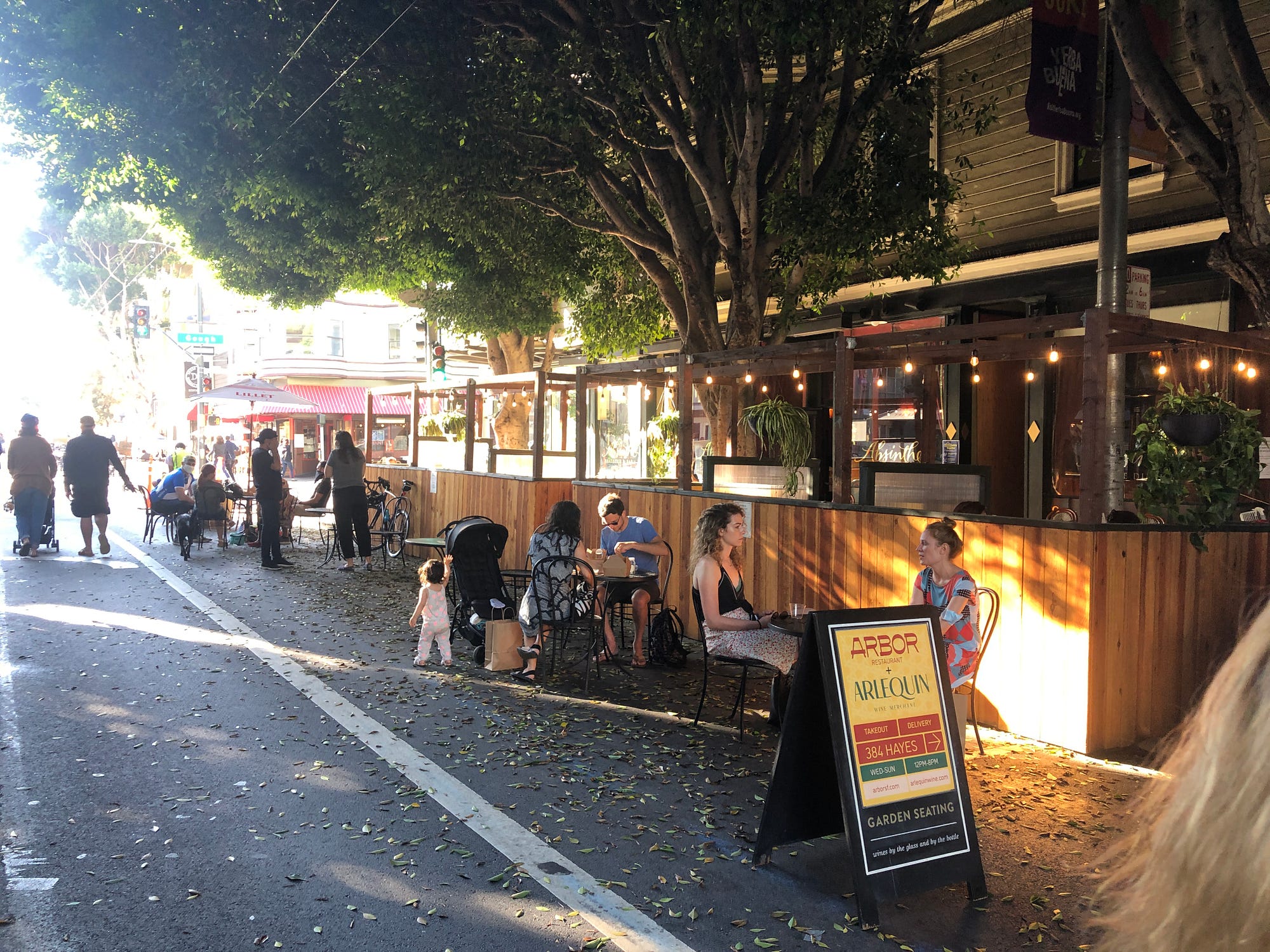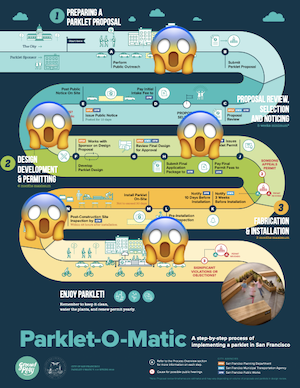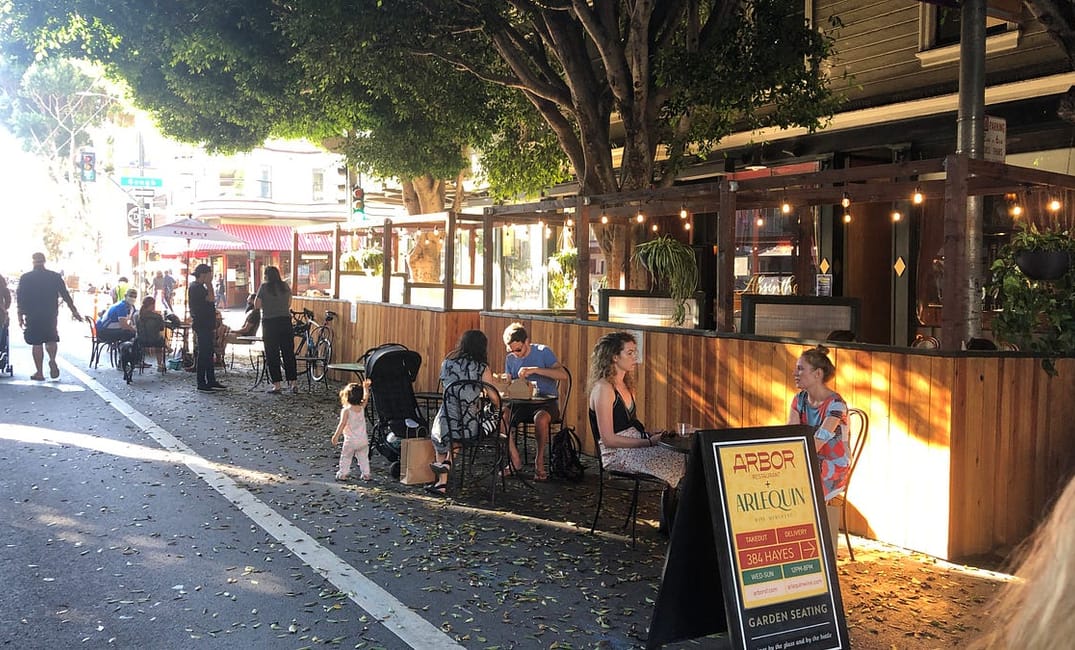
Sometimes good things don’t require a decades-long policy process. Most good things, I’d venture. The Covid-19 pandemic upset business-as-usual everywhere, and San Francisco’s bureaucracy was no exception. The city fast-tracked temporary dining parklets and an aggressive “Shared Spaces” program (weekend street closures for pedestrians) breezily, reallocating chunks of public space away from cars and in turn hugely improving civic life.
Who knew people like eating and hanging out outdoors?
It’s crucial now to recognize that although these programs (and others like them) were created to be nominally temporary, San Francisco should embrace the deep good in what it’s managed to create, rather than glumly rolling it all back as pandemic restrictions wane.
We can have nice things when we decide we want to have them.
The “Parklet” discussion dates back many years. They’ve existed for about a decade in SF. Prior to 2020, they were only permanent affairs — meaning, if a restaurant wanted to create one, it would be there for the long haul, with a lengthy permitting process (including design review and community input) and resulting high costs. Because of the long process, only a handful of these sprouted up around the city.

But, to help restaurants stay afloat when indoor dining was risky, the city did something very out of character last May: They tossed out nearly the entire labyrinthine process and let eligible businesses just… fill out a form online and pick up the power saws. No fuss. As long as you were meeting standard fire/access requirements, you no longer had to deal with arbitrary design review and or required community feedback.
You’ve seen what happened next. Like a Cambrian explosion of new and wild species, hundreds upon hundreds of parklets bloomed quickly across the retail corridors of the city as all sorts of businesses were willing to try anything creative to help alleviate their struggles. Currently, there are 1,500 parklets and climbing, according to Sharky Laguna, the president of the SF Small Business Commission. These parklets may be theoretically temporary, but the choice between some customers and no customers is often a no-brainer.
All different kinds of designs and levels of investment showed up; some with beautiful murals and carefully integrated planters, some literally made of barrels and milk crates and folding chairs. And people are using them! Suddenly, staid San Francisco streetscapes feel — dare I say it? — fun and weird and creative and human.

The range of parklet designs has been so charmingly broad — and working around the city’s handful of requirements to create our own new, local vernaculars — that I’ve been posting fun examples to my parklets_sf Instagram account for months and still don’t tire of them.
And more than this: They are being used and they are loved. San Francisco never seemed like a dining-outdoors city, did it? Maybe you’d have some sidewalk spaghetti on a nice night in North Beach once in a while, but we didn’t have the grand urban tradition seen in other places. Now? We are definitely a dining-outdoors city. As we should be! This is California, folks. All it took was… letting people do it. Let’s keep it this way.

Sharky Laguana recently publicized the results of a survey he did of users of street and sidewalk dining features. (He refers to this program by the proper umbrella name Shared Spaces.) The bottom line is that this is all incredibly popular. Over 90% of respondents wanted them to continue.
Now comes the part about having nice things. These temporary pandemic-era parklets are not perfect. There are some things to resolve around, for example, accessibility, city revenue loss from meters, management of trash, and conflicting access rights to shared street frontage (aka the width of the building that runs along the sidewalk). This is the sort of good-faith policy stuff that serious people should be — and fortunately, are — working out while considering how to make this program permanent.
But don’t give too much credence to other objections. “Street parking spaces,” for example, were not created by God on the third day, and although a permanent reduction in parking spaces along some commercial corridors may inconvenience some business owners and visitors in the short term, that’s just not a good enough reason to not do stuff.
You know how it’s still super annoying to navigate your car around downtown ever since they demolished the Embarcadero freeway in 1992? Yeah, me neither. In the long run, people adapt to change. You gotta keep your eye on the nice things. As Laguana says, “this might be the most popular project the city has launched since the Golden Gate bridge was completed in 1937.”
And speaking of changing traffic patterns…
Shared Spaces lets pedestrians thrive
Full street closures is another offshoot of the Shared Spaces initiative, which helps small businesses and neighborhoods by carving out pedestrian-only blocks of certain commercial corridors during certain hours — usually weekend daytimes and Friday evenings. Parklets expand into actual street-surface seating setups, artists set up tables, all the good stuff. People wander from shop to shop to restaurant to seating spaces.
My local favorites are Valencia in the Mission and on Hayes in Hayes Valley, though you can check out the full list on the SFMTA website. It’s like a street fair every weekend. What’s not to love?
As wonderful as these closed streets are, they do come with some problems to sort out. Businesses often need access by delivery trucks, and sometimes rely on customers being able to park nearby. Forcing visitors who drive to park outside the closure area snarls traffic there, a negative externality for both those drivers and the residents. Sometimes residents need access to their garages on closed blocks.
https://thebolditalic.com/announcing-the-absolute-best-parklets-in-san-francisco-92f26011ec82
But these are, again, good-faith challenges, and there are ways to resolve them in good faith, such as designing closure hours and boundaries to allow for deliveries. This kind of negotiation is already happening as local neighborhood associations work with their retail and resident communities. And that’s just with the current temporary situation.
The pandemic has allowed for a messy sort of grand experiment, and everyone is learning a lot about how we can do this better. This is how it should be! Going forward we can get technocratic about parking enforcement, incentivizing transit access, and other ways of tightening it up.
We can and should figure out how to formalize this program so that we get more permanent weekend closures, and perhaps even 24/7 closures in some areas that still allow for deliveries and emergency vehicle access.
Everybody loves Barcelona
Barcelona’s new “super block” concept has made waves around the world as they’ve pioneered pedestrian-only regions within dense city blocks. Anyone paying attention to urbanism news has seen the remarkable efforts in the Netherlands to remove parking spaces in favor of pedestrian and cycling infrastructure. By imagining a future with fewer cars in key areas, other cities reap the benefits of beautiful and functional pedestrian spaces. We can have this too!
The Dutch concept of a woonerf is a kind of shared street that prioritizes walkers and cyclists by only allowing some auto access at reduced speeds. San Francisco has experimented lightly with this idea in the form of the “Living Alley” program. Its most notable success is Linden Street in Hayes Valley, still the site of the original Blue Bottle kiosk. But the Living Alley program puts a lengthy and complicated, multi-departmental coordination burden on members of the public, and has seen only limited uptake to date.

You have to be willing to have nice things
Like parklets, the pandemic has freed us to experiment with proper street closure, and it turns out — it’s awesome! We should work backward from that popularity and lean into this. Even in the excitement to formalize and permanentize these popular programs, though, we have to keep a sharp eye out for the forces of policy gravity reasserting itself.
When you ask for people to offer feedback on city programs, often only the loudest voices are heard, and those voices might represent only a minority of stakeholders. Community input on how to operate these programs going forward seems important. But building too much community feedback into the program implementation itself will drag it down.
The parklets go up today in a matter of days, with no per-parklet meetings, and you know what? It’s basically fine. There exists a very San Francisco instinct: When in doubt, add another community meeting or public hearing or review step. This is a very well-intentioned instinct and it can also generate a lot of red tape. The reason we have such fun and creative parklets today is largely because we deregulated this process last year. The result is a bunch of nice things and we can have those nice things in perpetuity if we let ourselves.
Our city leaders — supervisors, mayor, community groups — are stewards not just of the current city as it exists, but must also be keepers of — and fighters for — an affirmative vision of the future of San Francisco. The pandemic has presented a surprising peek into ways that our city can continue to step up and be an example of the world-class city that it rightly is. We should seize the opportunity not to roll this stuff back but to hold tight and (thoughtfully) push forward with it as far as we can go.
If you want to see Shared Spaces continue — parklets, street closures, and the like — the city is listening and it makes a difference when they hear about your love for public space access. Please send an email to your supervisor and tell them what you think!
Sign up for The Bold Italic newsletter to get the best of the Bay Area in your inbox every week.







